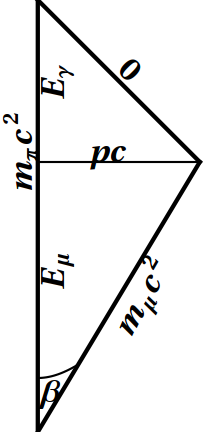You are here: start » book » gsr » hwcolliding4
Colliding Particles IV
A pion (mass $m_\pi$) at rest decays into a muon (mass $m_\mu$) and a massless neutrino ($m_\nu=0)$. Find the momentum $p$, the energy $E$, and the speed $v/c$ of the muon in terms of $m_\pi$ and $m_\mu$.
 Figure 10.6: Spacetime diagram for the decay of a pion.
Figure 10.6: Spacetime diagram for the decay of a pion.
This problem can be solved by brute force algebra; we present a more geometric solution. A momentum diagram showing this collision is given in Figure 10.6. The vertical line represents the pion at rest; the magnitude of this line is the pion energy $m_\pi c^2$. The muon is shown moving to the right at speed $\frac{v}{c}=\tanh\beta$; the magnitude of the hypotenuse of the lower triangle is the muon energy $m_\mu c^2$. The upper triangle is isosceles, showing the massless neutrino; the vertical leg of this triangle is the neutrino energy $|p|c$.
Conservation of energy-momentum is built into this diagram; we have first of all that \begin{equation} |p|c = p_\mu c = m_\mu c^2\,\sinh\beta \end{equation} and then that \begin{equation} m_\pi c^2 = E_\mu+|p|c = m_\mu c^2 (\cosh\beta + \sinh\beta) = m_\mu c^2 e^\beta \label{decayeq} \end{equation} We have therefore shown that \begin{equation} e^\beta = \frac{m_\pi}{m_\mu} \end{equation} so that \begin{eqnarray} \sinh\beta &=& \frac{e^\beta - e^{-\beta}}{2} = \frac{m_\pi^2-m_\mu^2}{2\,m_\mu\,m_\pi} \\ \cosh\beta &=& \frac{e^\beta + e^{-\beta}}{2} = \frac{m_\pi^2+m_\mu^2}{2\,m_\mu\,m_\pi} \label{decaycosh}\\ \tanh\beta &=& \frac{\sinh\beta}{\cosh\beta} = \frac{m_\pi^2-m_\mu^2}{m_\pi^2+m_\mu^2} \end{eqnarray} Thus, \begin{eqnarray} p_\mu &=& m_\mu c\,\sinh\beta = \frac{m_\pi^2-m_\mu^2}{2\,m_\pi} \>c \\ E_\mu &=& m_\mu c^2\,\cosh\beta = \frac{m_\pi^2+m_\mu^2}{2\,m_\pi} \>c^2 \\ \frac{v}{c} &=& \tanh\beta = \frac{m_\pi^2-m_\mu^2}{m_\pi^2+m_\mu^2} \end{eqnarray}
Alternatively, we can avoid the use of $e^\beta$ by rewriting ($\ref{decayeq}$) in the form \begin{equation} m_\pi - m_\mu\cosh\beta = m_\mu\sinh\beta \end{equation} Squaring both sides of this equation and using the fundamental relationship $\cosh^2\beta-\sinh^2\beta=1$ quickly leads to ($\ref{decaycosh}$), from which $\sinh\beta$ and $\tanh\beta$ can be obtained using (hyperbolic) triangle trigonometry.